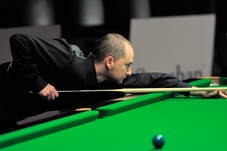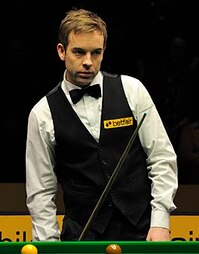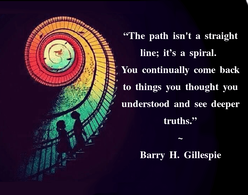 As Graeme Dott battled his way to the Snooker Grand Prix Final against Tom Ford, his opponent was several times credited with improvements in mentality thanks to working with a ‘mind coach’. Less spoken of is Graeme's own struggle against depression (BBC article linked behind the image: image courtesy Wikipedia). In the closing stages, Tom came back to square the match until Graeme took on a difficult shot, fluked two reds and landed plum on the black for the frame. Snooker is unique in many respects, not least because the table plays too. Other ball games rely on straightforward laws of physics - whether you’re winding from the tee across turf or kicking a football to a team-mate, the ground doesn’t play one off against the other like the green baize does. You’ll often hear commentators say that when the balls are with you, they’re with you, and when they’re against you, there’s nothing you can do. The table, as Steve Davis said, is very much a third player.  All ball games are psychological to some degree. But generally speaking, consistency comes to light in a singular performance. Not so in snooker. A player can turn from one frame of mind to the other in a matter of minutes, from elation to catastrophe in one foul swoop. Perhaps this is the reason it’s become so popular. If you can handle the silence, there’s never a dull moment. Ali Carter (meet him here) is another player with troubled stories to tell. Battling cancer and various mental frailties to reach his present form, he’s enjoying an increasing level of well-deserved popularity in the wake of fraught experiences. In the UK Championship final, he showed the merit of his talent. His personality exudes quiet warmth and backing him is joyful, like a real fire in winter. The thing that sets snooker apart is rooted in quantum principles. Mechanics come into it with angles and geometric analyses, but you don’t get down to a ball and work out the maths. I know how it feels when the object ball ‘talks’ to you, telling you exactly where to strike, while your job is to wait for that point of accuracy as you feather and make sure you cue the white to leave it in the right place for later. You judge an angle walking into the shot, but successful execution is as reliant on the ball telling you what to do as it is on your notion of where the pocket is. So-called ‘blind shots’ where you can’t even see the pocket show this communication system at work.  Attitude on the table also makes a big difference. Flukes happen in favour of one player or the other, but rare it is to get a fluke and land yourself with the next pot when you’re just not ‘into’ the game. You’re much more likely to end up snookered from a fluke if you’re feeling in any way fragile. This tendency for the table to intervene can change on a moment-by-moment basis, so whatever is going through a player’s mind is as important as what’s on the cloth at the time. That's me there, by the way, 38 years ago. Things were different then. Mental health is big potatoes right now. We hear many stories of vulnerability and valiant journeys to success across the whole range of popular sports - snooker is no league winner there. But in terms of its ruthlessness in forcing you to take account of quantum law, snooker is unparalleled. There are direct synergies between learning to play snooker and learning valuable tools in mentality. Like life, it’s tough - in getting proficient enough to beat the odds, you dedicate yourself to the task. But wherever you get to, it’s worth it, just as someone promised life would be.
0 Comments
 Two words synonymous with change. Spires are spiral by design, and words that contain this geodesic are rare. You can breathe easy - respiration says so. "Geodesic" might seem like an ambiguous term here, but bear with the definition as on dictionary.com: "Noun. A curve that locally minimizes the distance between two points on any mathematically defined space, such as a curved manifold. Equivalently, it is a path of minimal curvature. In noncurved three-dimensional space, the geodesic is a straight line." Spires (architecturally) are typically considered to comprise straight lines from a collection of points (at the base) to a single point (at the apex) - a spiral is comprised of curves denoting the shortest possible path from one point to the next traversing the circumference at any given point in the geometry of the spire. A differential addressed by WikiDiff thus: "... the difference between spiral and spire is that spiral is (geometry) a curve that is the locus of a point that rotates about a fixed point while continuously increasing its distance from that point while spire is (geometry) the part of a spiral generated in one revolution of the straight line about the pole. As nouns the difference between spiral and spire is that spiral is (geometry) a curve that is the locus of a point that rotates about a fixed point while continuously increasing its distance from that point while spire is or spire can be one of the sinuous foldings of a serpent or other reptile; a coil. As verbs the difference between spiral and spire is that spiral is to move along the path of a spiral or helix while spire is of a seed, plant etc: to sprout, to send forth the early shoots of growth; to germinate or spire can be (obsolete) to breathe. As a adjective spiral is helical, like a spiral." So the two definitions seem related but confusing, although it could easily be said that "spiral" is the collective noun for "spire". The seedling uncoils from a spiral, developing in a Fibonacci sequence of cellular repetitions to produce its adult form. Notwithstanding that all this is metaphorically describing something we already understand. Like the helix of that DNA strand we've never seen other than in CGI...  Okay, so enough of that. What about real life? There's so much doom and gloom around that it's hard to think straight. In the UK, we found ourselves sold down the river by our leaders. Being British, we're likely only to sulk quietly in our little boxes and complain to each other over the odd drink. History repeats itself, civilisations get corrupted. The point of origin seems always to be money. Oh dear, never mind, it'll all come right in the end. At the top of any apex is a singular point at which you can say, "there it ends". There may well be a new beginning after the point of completion, of course, but that phase of life is over, as it were; the spire of your aspiration has reached the singularity where the laws of physics break down. Inspiration being the fuel that gets us there, it stands to reason (if you credit language with any synchronicity in its creation, that is) that "Insp" is 'within' and "Asp" is 'without', or 'lies back of' as Florence Scovel Shinn put it. Look her up via the link - she was way ahead of her time.  Should we aspire to share our inspirations in the course of ascension from baseline to singularity, we touch a lot of lives. Family, loved ones of all kinds, even those harder to love can take a moment from an inspiration you shared. Inspired thus, even if fleetingly, they can take a step up their own staircase to the next level, which you helped them to manifest. Let's for a moment let nothing be coincidence. That DNA spiral repeated throughout your physical form, it lets us know that the foundations of nature - including our own composition - rely on spiral networks to exist. In science you're likely to find a similar word referencing all kinds of variants - the word is "Chiral". scroll through the list here in Wikipedia and the correlations become very clear. Better still, read the brilliant article by Philip Ball, linked to the image of bees above. Exploring the foundations of Quantum Mechanics, you'll find it opens doors to new appreciations and ways of thinking that prove extremely useful over time. Arguments over choice v. destiny will rage on no doubt, but at the end of the day it's your life, my life, all lives with those chiralities to contend with. We can always start again, any time we like. |
AuthorKathy is the author of Quantumology. She met up with quantum mechanics in 1997, pledging allegiance to its sources thereafter. These are her personal thoughts and testimonies. Archives
April 2023
|
 RSS Feed
RSS Feed